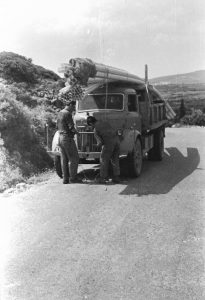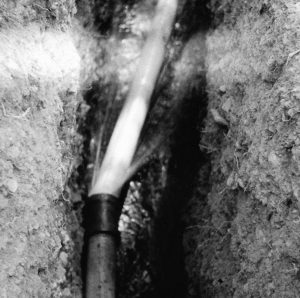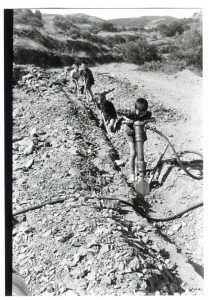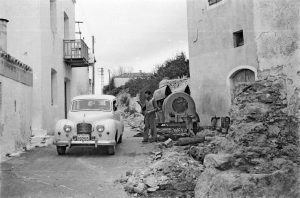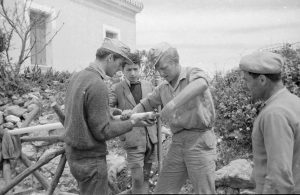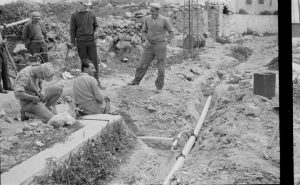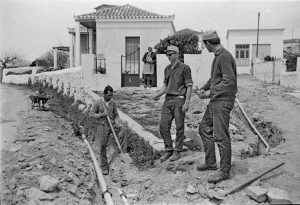Search for domestic water at Kythera in the sixties and how Karavas, Logothetianika and Potamos as earliest villages got their water supply system.
When George and Anna Koksma arrived by car from Holland at Kythera by the end of April 1960, to improve on request of Bishop Meletios living conditions on the island, only Chora at that time had a water system for household use. All other villages on the island had to putt water from municipal wells or built-in wells for rainwater catchment from the roof.
It was clear from the beginning that to install anywhere a water system one first had to find a suitable water source. Next thing was where to get the pipes for transportation of the water? The coming 6 months they searched with locals and or Bishop and or governmental officials around many villages and in surrounding gorges. Only at a few places enough water was found that eventually could be used as domestic water.
About the donation of the plastic pipes from Holland
The 4th day of their being at Kythera a meeting was held in Chora with a lot of island officials to discuss this greatest of all problems: the lack of water in the villages. Three weeks later George, confronted with the enormous water problem at the (old) hospital in Potamos, writes his first request for plastic pipes to the Dutch firm Wavin in Zwolle/ Hardenberg. Within 6 weeks George received a favourable reply! Yes, they are willing to donate pvc pipes, but first they want to see the applicable designs. With this information George could start the search for water, knowing that at some time he also could provide the necessary pipes.
Now, early 1961, three villages were selected, surveys done, and preliminary plans drafted. In March 1961 being in Holland on a work vacation, George met Mr. van Veen of the Wavin-firm in Zwolle with a very satisfactory result. Also, at an Interchurch meeting, George laid the first contacts through Mr. Spliethoff with the HTS (Higher Technical School) of Arnhem. This had as result that 4 technical students in 1962 for 6 months could come to Kythera to help George with a multitude of topographical surveys, technical drawings and also could supervise the installation of the water supply systems in the 3 villages. Mid-December 1961 George is informed by Wavin that they will prepare a shipment of 10 tons of plastic pipes of various diameters but to do so they need detailed layouts with calculated pipe sizes. These easily were provided. George writes another letter for iron spare parts from Wavin to Mr. van Veen on 26 January 1962. The 4 Dutch civil students, Martin, Wessel, Eric and Jean Bingen, arrived after travelling 56 hours by train and next day by ferry on 31 January at Kythera. Martin and Wessel had been before at the Wavin-factory to learn how to fit the plastic pipes. The pipes thus arrived at Kapsali 17 April 1962. Transport of the plastic pipes from Piraeus to Kythera costed 26.000 drachmes and had to be paid by the Team.
*Click on a photo to enlarge
Early July 1960 George with Anna and several local helpers started a topographical survey at Karavas in nearby Diakopoulianika. Immediately this is noted by people from Prongi and Gerakari. A farmer Gerasimov is very much opposed and together with 8 other people they write an angry letter to the Bishop and Koksma, stating that in no way they will allow their water to be touched for use in Karavas. A relative of Gerasimov even will not allow pipes crossing her property! Bishop Meletios talks to the man, but to no avail. The man is stubborn as the proverbial donkey. As nobody wanted to give in, George suggested the following solution: one cistern should be built and the water for domestic use should be evenly distributed between Gerakari, Prongi and Karavas. The surplus of water then could be used in their gardens. This was happily accepted by all concerned. From now on Mr. Gerasimov behaved very well towards the continuation of the survey. By the end of the month a water source across the valley, opposite Diakopoulianika and halfway Prongi, proved to give enough water. Early December 1960 technical plans were ready to be sent to Holland. It took until the end of December 1961 that George in a heated discussion in the village mentioned that the spring Mangano could supply enough water for Karavas. Of course, this was objected by the owner of the spring. Only after George promised to measure the daily available quantity of water and not to touch it if it did not suffice also for the owner and his garden. Again, an agreement was reached, keeping everybody happy. Early June 1962 the village officials inform George that they do not want the type water tower as for Logothetianika. A drawing is then made to suit their wishes.
In May there came a request for the installation of some pipes near Kryoneri. Several small springs had to be connected to a new concrete basin from where pipes were installed to where they wanted to use the water.
At Logothetianika things went much better. A survey was done end of July 1960, a design for a water tower was made and people started collecting money to pay for its construction. In September 1961 enough money was available to start the final design for the construction of the concrete water tower on top of a storage room built with natural stone. The required steel rebar was calculated early December 1961 by the young Dutch architect Keimpe Jellema. A local civil contractor was found end February 1962 willing to build the water tower for 13.000 drachmes. April 23 and 24 student Jean Bingen supervises the concrete pouring of the walls. They use a clever system, after every 15 to 30 cm pour they add another layer of the timber formwork. Readied concrete, some 25 to 30 kg, is lifted in metal tins carried on the shoulder up the ladder to be poured. The roof is poured May 10. Student Wessel supervises the digging of trenches and the installation of pipes.

Potamos was totally different and difficult. Village officials wanted the Team’s money and the pipes but not their design, because they already had one from the “Nomarchia” as they said by the end of September 1960. Anyway, George and Anna had finished their survey and the technical drawings by mid-December. Mr. Sinis, chief engineer from the Nomarchia, who February 1961 compared their own plans with the one from the Team, was amazed by the differences. In first instance therefore, he ordered George to adhere to the plan of the Nomarchia. George was not happy at all, he was supposed to work in future in close cooperation with Mr. Sinis, so now what? But when Mr. Sinis had a closer look at his own plans, he noted that streets and alleys were not drafted in the correct places and that the village should follow the design George had drafted. For this, George future cooperation with Mr. Sinis looked bright again.
In May 1961 the new well being dug at Potamos still had no water at 10 meters depth. Mid-July George is not confident with the construction of the cistern and informs the Nomarchia by letter. More unwelcome news in October, the cistern is located too low!
Digging of trenches and the installation of pipes
Potamos was the first village where the digging of trenches by local people started which was continued after Easter in early May 1962. Here student Martin supervised the work. In all the 3 villages local officials organized the availability of village people and the required tools to dig in the mostly rocky subsoil. Eric and Jean did help Martin in the beginning, also to learn how the fitting of pipes had to be done. Wessel supervised in Logothetianika where everything went more smoothly. Eric and Jean went first to Diakopoulianika to survey a route from the spring Mangano across a brooklet in the valley to the location where the cistern, with walls in natural stone, had to be built. The location for a required pump station across the valley in the slope towards the cistern was set out. A concrete bridge, spanning the brooklet, was poured by local people.
The plastic pipes that arrived in Kapsali were of 10 m length and had to be transported to the villages by trucks. The pipes being so long, extended front and rear of the truck causing that the pipe ends swayed such that they touched the ground, were damaged and had to be shortened before installation.
Arrival of deep well drilling equipment
Already in September 1960 there had been discussions that the first well to be drilled should have been in Kato Livadi, but it took until June 1965 that the required drilling equipment arrived at Kythera. A first drill is made at Logothetianika and in July already 200 m3 per day water is found at one hundred meters depth. The drilling was continued up to 130 m depth where a 1000 m3 per day water is found. The Bishop requested the Team to make a survey from the location of the well for a pipe connection to the hospital at Potamos in April 1966. The technical students Anton and Alex surveyed two possible pipe routings for the Nomarchia to decide on. Early 1966 a first attempt to find deep well water at Livadi is not successful, this took until a 2nd one hit water in August. The Team was also asked July 1966 to make a road to the next to be drilled deep well near Frilingianika.
*The 4 technical students at work in Potamos together with the local people, click on a photo to enlarge
**Click here for more photos of 1962
Bringing into use of the domestic water supply systems
For Logothetianika this was already in 1963. See the German article “das Wasserleitungsfest von Logothetianika” by Walter Stölting. For Potamos this took until the deep well drilled near Logothetianika (1965) was connected by a pipeline to Potamos. On request of the Bishop first the hospital had to get a connection and afterwards the village.
What about other villages?
May 1960: People from Trifyllianika had the idea to pump water from the valley towards Paleochora into a cistern for a multitude of purposes; At Karvounades and Kondolianika they wanted a cattle-drinking place higher up in the village; Mylopotamos had from somewhere enough water, they thought; A visit to Gonia, east-northeast of Mitata showed lots of water (Nowadays there is located a pump station with a deep-well);
June 1960: the wells in the gorge at Paleochora are already drying up. This is not helpful for a solution for the hospital in Potamos! Much water is found near Agia Pelagia; No water close available for unlucky Fratsia;
July 8: a renewed visit to Gonia with the Bishop and agricultural engineer Mr. Plastiras and indeed water was found;
July 16 at Mylopotamos there was found enough water on a private property. However, the rich owner, who actually did not need all that water, refused, even after a request of the Bishop, to let the surplus water be used by the village (the start of the supply pipe for domestic water in Mylopotamos was by a Dutch summer camp in 1967 and later on finished by local people in November);
July 21: the amount of output of wells around Potamos is questionable;
July 26: east of Alexandrades no good wells only one at west side;
July 29: survey at Gerakari to avoid envious trouble with Karavas;
September 8: complaints from hospital, not enough water is being pumped up from blacksmith shop to the small cistern on top of roof;
Sept 12: to get water from spring Loutrou or Agia Mamas for Petrouni is impossible. According their village president there lived 200 people, but that number proved to be only 85;
Sept 17: could at Kato Livadi the first Artesian well be drilled?
Sept 22: in Chora Mr. Skonakis investigation on island water resources is discussed.
1961 January 21: ideas discussed for an overall island water supply system (in May 1966 Mr. Panagasis, civil engineer of the Nomarchia, visited, with transportation help of the Team, all villages and noted what kind and quantity of water was available. In the Team’s office he was shown old and new plans the Team had for a lot of villages. The wish to cooperate with the Team was repeated in June and July.);
Jan 22: deep well drilling still out of reach;
June 19: survey for Petrouni finished, but spring is located more than 120 m lower, 2 other springs to be considered;
Sept 19: owner of spring at Agia Pelagia does not want to share his water, he needs it all for his garden;
Sept 23: from Kalokairines a request to make a plan for the use of water found in a well that had been dug;
Oct 3: in Kalisperianika well and cistern were ready, only the cistern was located lower than the houses;
Oct 7: the Team’s plan for Mylopotamos was rejected by the village council, although the Nomarchia, according to Mr. Sinis, would have approved;
Oct 28: the Nomarchia more or less promised that a deep well drilling for Frilingianika could solve their problem;
Nov 14: visiting Paleopolis to locate a place to dig a huge well;
Dec 5: the Nomarchia asked Fratsia’s municipal secretary to check on available water quantity in the gorge. (A topographical survey for Fratsia’s domestic water supply was done by the 2 last technical students Frank and Harry in 1967.)
1962: This survey for Fratsia in the brooklet was done by the technical students, walking from the church Agia Kyriaki down the slope of the gorge on 11 April;
March 20 thru 24: topographical survey of Livadi for a domestic water supply by 3 students. Plan was drafted by student Wessel
1966 Water project Livadi. This project was sponsored by ecumenical youth from the Dutch town Vlaardingen in 1966. They also sent 2 summer work camps to start the trench digging, laying part of the pipes and the excavation of the foundation for the water tank.
6 August 1969 the domestic water supply system was officially opened. By then in 1969 nearly all villages had got electricity.
1966 Water tank for domestic use in Avlemona under construction. Survey in Mylopotamos by technical students Jan and Alex for domestic water and irrigation plans for the village.
1967 Domestic water for Mylopotamos: A part of a Dutch summer work camp at Mylopotamos started trench digging. Promised plastic pipes for Mylopotamos and spares for Livadi arrived in October. This was a donation of the Dutch Ecumenical Youth Council (O.J.R.). Another Dutch donation of 1000 m1 pipe from the Christian Rural Youth Society was also received.
1968: The Government has contracted several civil contractors to start the required work on the overall island water supply system in February 1968. At Fratsia a Dutch summer work camp started trench digging and laying the pipes.
1969 Plastic pipes are being installed in April: 1000 m1 in Kalamos and 800 m1 in Kapsali
Ideas to stop a too fast run-off of rainwater
Aug 1960: Mr. Tsikleas from Australia offered ₤ 10.000 for a dam to be located near Mitata/Viaradika. The foundation of this dam was laid by youngsters from the Myrtidia summer camp August 1960
Oct 1960: the chief forester for the district advises: 1) cover mountains with thick rapidly growing and leave-losing brush; 2) to build dams higher up the mountains; 3) widen the rivers where otherwise fertile fields could be eroded
*Interesting read Water and Trees
Sept and Nov 1961: investigation south of Agia Pelagia for a location of a dam
Dec 1961: Mr. Heracles Tsitsilias from America promised 20.000 drachmes for the first dam in Agia Pelagia
1964: A 350 m3 rainwater catchment concrete basin is built at Gerakari. Below Agia Moni a rainwater catchment basin is built for 40 m3.







